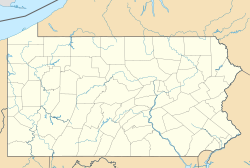Mauch Chunk & Summit Hill Railway
|
Mauch Chunk Railroad
Summit Hill & Mauch Chunk Railroad Mauch Chunk and Summit Hill Switchback Railroad |
|

Looking down at the Lehigh Canal landing, circa 1870.

Pisgah Mountain and the topography of the Summit Hill and Mauch Chunk Railroad
|
|
| Location | Between Ludlow St. in Summit Hill and F.A.P. 209 in Jim Thorpe, Carbon County, Pennsylvania |
|---|---|
| Coordinates | 40°52′10″N 75°44′59″W / 40.86944°N 75.74972°WCoordinates: 40°52′10″N 75°44′59″W / 40.86944°N 75.74972°W |
| Area | 47 acres (19 ha) |
| Built | 1827, improved 1830s |
| Built by | Lehigh Coal & Navigation Co. (LC&N) |
| Architect | Josiah White |
| NRHP Reference # | 76001616 |
| Significant dates | |
| Added to NRHP | June 3, 1976 |
| Designated PHMC | May 25, 1971 |
The Mauch Chunk and Summit Railroad was a coal hauling railroad in the mountains of Pennsylvania that operated between 1828 and 1932. It was also the first operational US railway of any substantial length to carry paying passengers.
A private line which moved coal for the Lehigh Coal & Navigation Company on 3 foot 6 inch gauge track, it was not a common carrier which linked with other railroads. The rail line was laid on top of the company's earlier 9 miles (14 km)-constant-descent-graded wagon road and trains would run for over a hundred years until the middle days of the Great Depression.
Pennsylvania's first railroad and first anthracite carrier opened on Saturday, May 5th, 1827, when seven cars of coal passed from the Summit Hill mines of the L.C.&N. Company to their canal at Mauch Chunk, descending 936 feet in the nine-mile trip.
It was the second operational (permanent) United States railroad, the first over five miles long, and like its rival B&O Railroad, Mauch Chunk began using humble animal power to return its coal tub consists up to the summit—the mules were sent down in the last batch of cars and the return trip required 4-5 hours.
Subsequently, the road would send down groups of 6–8 coal cars under control of a brakeman, and once 40–42 cars were down, send down the special "mule cars" with the draft animals, thus having just enough animals to return all cars back to the top. so became a combined gravity-incline plane combination railway with two steep cable railroad lift sections. A powered double-incline plane road led up to the top of two separate summits along Pisgah Ridge on the return leg and each summit had "a new down track" returning the cars several miles farther west in each case. This saw-tooth elevation profile gave the new return track a swooping characteristic ride later deliberately designed into roller coasters. About the same time, when other mine heads were opened in lower elevations of the Panther Creek Valley LC&N added several descending switchback sections and other shorter cable railway climbing inclines to bring the coal up from the new Lansford and Coaldale mines to the Summit Hill loading area for the gravity railway trip down to Mauch Chunk, thence to the Lehigh Canal (and in 1855, by rail transport) and their clamoring customers. The railroad became an early American tourist attraction and is considered as the world's first roller coaster, a role it would keep and satisfy with tourists for over five decades after it was abandoned as a primary freight railroad.
...
Wikipedia


